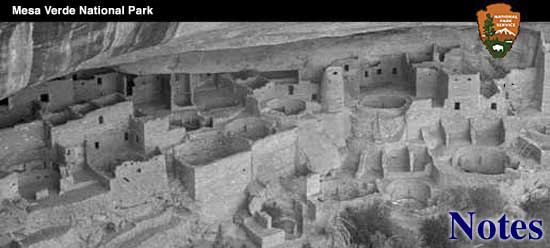

|
From the typically small doorways in the ruins and the limited space of the secular rooms, visitors in Mesa Verde are invariably given a first impression that the Cliff Dwellers were a race of dwarfs. Although never accepted as a tenable position, this theory has been refuted with difficulty for want of reliable evidence upon the subject, and it was with the hope of establishing some definite approximation as to the probable height of the Mesa Verde Pueblos that the investigation herein described was undertaken. Rather remarkable in research on the problem is the conspicuous lack of data to be found in previous literature. From the pioneer work of Nordeskiold1 down to present-day archaeological writings, reports on excavations have consistently avoided any suggestion as to the stature of skeletal remains. The Swedish Baron in his notable volume, THE CLIFF DWELLERS of the MESA VERDE, speaks at length of the skeletons and mummies which he unearthed as do Roberts2 and Morris3 in their exhaustive reports, however, no study of probable height was undertaken. The paucity of complete skeletal remains in the Mesa Verde area accounts no doubt for the absence of printed data in such records as those of Doctor Fewkes4. Among historic Pueblo Indians there is also little available material. In a report of 1539 to Charles V, of Spain, concerning his explorations in the Southwest, Captain Melchior Diaz5 describes the Pueblos of the period as men of small stature, while in Castenada's account6 of Coronado's expedition, we find no mention of height.
From the stature of various modern Pueblo tribes of the Southwest, who unquestionably are directly or indirectly descended from the ancient Cliff Dwellers of the Mesa Verde, we may draw certain conclusions relative to the prehistoric Pueblos. Dr. Ales Hrdlicka7 has found the average height of 383 males of ten modern tribes to be 5 feet 4-3/4 inches, that for 59 Pueblo women being calculated at 5 feet. Although it is frequently believed among physical anthropologists that the more favorable conditions under which the modern Pueblo lives might easily have added somewhat to his stature, just as has happened in various European countries, Hrdlicka's investigations would indicate that hereditary rather than environmental factors are more potent in determining this bodily characteristic.
Concerning the ancient Pueblos we must also turn to the studies of physical anthropologists for a solution of of our problem. Of the 1823 skeletons unearthed by Kidder in his excavations of Pecos, 1254 of these best preserved were made the subject of a critical study by Doctor A. E. Hooten of the Peabody Museum. Utilizing the well known formulae developed by Karl Pearson8, whereby the height of the individual is attained from almost any one or combination of the long bones, Hooten9 seems to have arrived at reasonable conclusions with the Pecos remains. The mean stature of 152 males of all periods included in the occupation of the pueblo he finds to be 161.74 centimeters or 5 feet 3-2/3 inches. None of the subgroups into which the skeletons were classified can be said to differ significantly from the mean of the series, and the standard deviation of 4.3 centimeters may be considered exceptionally low, in that 68 percent of the group range from 157.44 centimeters to 166.04 centimeters. The females also present a remarkable constancy in stature, the average concluded as 150.11 centimeters or 4 feet 11 inches. Hooten like Hrdlicka, from the results of his critical study of the Pecos skeletons, is of the opinion that any explanation of depression of stature ascribed to environmental deficiencies cannot be successfully invoked.
To measurements of of the few skeletons unearthed by Nordenskiold at Mesa Verde, the Pearson formulae was applied with results which suggested a total height of 5 feet 5 inches for males and 4 feet 11 inches for females figures roughly corresponding to those calculated by Hooten for the ancient Pecos Pueblos. A number of bones preserved in the Park Museum of subjected to anthropometrical investigations, would indicate a probable stature of slightly more than that computed from Nordenskiold's data, but in both cases the scarcity of burial remains and the difficulty incident to establishing them definitely as to sex minimizes very much the value of any conclusions from them. With the late Mesa Verde culture roughly contemporaneous with the earliest of the Pecos civilization, one can be safe in approximating the average height of the male Cliff Dwellers as between 5 feet 4 inches and 5 feet 5 inches, and 4 feet 11 inches to 5 feet for the female inhabitants. Comparisons with modern Pueblos and observations from bones excavated at Mesa Verde would seem to substantiate these figures. In past times Mesa Verde burials have been found that showed a male stature in excess of 6 feet, but such cases may be considered among the usual relative exceptions. Considering the natural affinity of the Pueblo for crowded living conditions, one can readily understand the narrow entrances and cramped quarters seen in the cliff house ruins. Compared to the height of the average American soldier in the World War of little more than 5 feet 7 inches, with most of those under 5 feet 5 inches eliminated, it is apparent that while the Mesa Verde population was slightly smaller in stature than present-day Americans, they may in no sense be called a nation of dwarfs. | ||||||
| <<< Previous | > Cover < | Next >>> |
vol3-2b.htm
14-Oct-2011